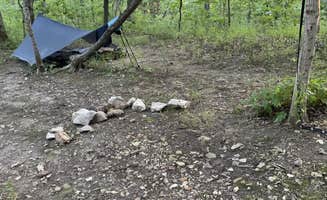Dispersed camping near Augusta, Missouri offers primitive backcountry experiences within the Mark Twain National Forest. Most sites sit at elevations between 700-1,000 feet with typical forest terrain of oak and hickory woodlands. Winter temperatures regularly drop below freezing while summer brings hot, humid conditions with frequent thunderstorms, requiring campers to prepare accordingly for seasonal weather variations.
What to do
Hiking and biking trails: Brazil Creek Camping Area provides extensive outdoor recreation opportunities. According to James D., there are "Miles and miles of trails for Mountain Biking, horse riding or just hiking, and you can ride your ATV on the roads but you need an orange triangle." The area connects to the Berryman Trail system, making it ideal for mountain bikers.
Fishing opportunities: The creeks and waterways around Courtois Creek Dispersed offer excellent fishing. Jen notes, "The water is amazing. Great for fly fishing and cast fishing." Bring appropriate tackle and check Missouri fishing regulations before your trip.
Night sky viewing: The minimal light pollution at remote sites creates excellent stargazing conditions. Chelsea G. describes her experience at Courtois Creek: "I'm soaking up the stars and the moon and the sound of running water," highlighting the natural night sky visibility in the area.
What campers like
Natural water features: Many campers appreciate the creeks and lakes available for recreation. Pat F. describes Courtois Creek as "Very scenic and beautiful right on the river" with sites that allow direct water access for swimming and cooling off during hot weather.
Seclusion and quiet: Timberline Lake Dispersed offers an off-grid experience away from crowds. Cody S. reports a "Peaceful night, very off the beaten path," noting the remote location provides true wilderness camping without nearby neighbors.
Wildlife viewing: The natural forest setting supports diverse wildlife. While camping at Brazil Creek, Linda C. noted the area was "Small and picturesque" with "Beautiful country drive from 1-44" and "Abundant shade," creating ideal conditions for observing forest creatures in their natural habitat.
What you should know
Road conditions: Access to dispersed sites often requires navigating challenging terrain. Nicholas H. cautions about Courtois Creek: "The road to get there isn't a road so much as a ATV trail. All wheel drive and it was too hard on my Subaru. Mostly washed out." However, experiences vary as other visitors report successful passage with careful driving.
Cell service limitations: Communication options are restricted in these remote areas. Alexis M. reports that Brazil Creek has "No Verizon signal," while other campers note similar connectivity issues throughout the region. Plan accordingly by downloading offline maps and informing someone of your itinerary.
Limited facilities: Most dispersed sites lack basic amenities. Linda C. mentions at Brazil Creek that the "Water source is creek" and there are "Lots of sewer flies in the vault toilet," indicating campers should bring all necessary supplies including drinking water.
Tips for camping with families
Safety preparation: Remote locations require additional safety planning. Chelsea G. recommends considering sleeping arrangements based on comfort level: "As night fell and the animal sounds picked up, I decided to sleep in my car instead of the tent," demonstrating the importance of flexible shelter options.
Supply logistics: Brazil Creek Camping Area requires advance planning for provisions. Mike L. advises, "Make sure you stop in Sullivan or Bourbon, MO for supplies. This site is pretty remote from any services." Pack all necessary food, water, and emergency supplies before heading to camp.
Swimming spots: Several creeks offer natural swimming areas for children. Pat F. notes families regularly visit Courtois Creek: "We were the only people camping there until the next afternoon when a couple families came down with kids to swim and float." Check water levels and current strength before allowing water activities.
Tips from RVers
Vehicle clearance requirements: Lone Spring Trail Backpacking Campsite and other remote areas present challenges for larger vehicles. Michael M. mentions the site "has several areas to setup a tent has a metal fire pit," but access may require high-clearance vehicles depending on recent weather conditions.
Turnaround space: Planning for vehicle maneuvering at narrow forest roads is essential. When visiting Courtois Creek, Chelsea G. cautions, "You can not turn around anywhere on this road; you have to go to the end where there's a loop or worst case scenario reverse out while ideally not in a state of panic." Scout ahead when possible before committing to narrow access roads.
Traction considerations: Weather significantly impacts dispersed camping accessibility. Cody S. notes about Timberline Lake: "need AWD to get there on gravel roads. There is a boat launch that's steep and rough," highlighting the importance of appropriate vehicle capabilities when accessing remote sites.


